Finance 211 Case Study: Capital Budgeting Analysis of DBP Project
VerifiedAdded on 2023/06/13
|6
|733
|418
Case Study
AI Summary
This case study presents a comprehensive capital budgeting analysis for Dimples Baby Products (DBP) and their new Vegey Goo pablum project. It includes calculations for Net Present Value (NPV), Internal Rate of Return (IRR), and payback period, considering factors such as unit sales, variable and fixed costs, capital cost allowance, and a non-taxable cash grant. The analysis assesses the project's profitability based on NPV, IRR, and payback period, while also discussing the impact of market demand and consumer preferences. The positive NPV and IRR, along with a short payback period, suggest the project's financial viability. The document is a student contribution available on Desklib, a platform offering study tools and resources.
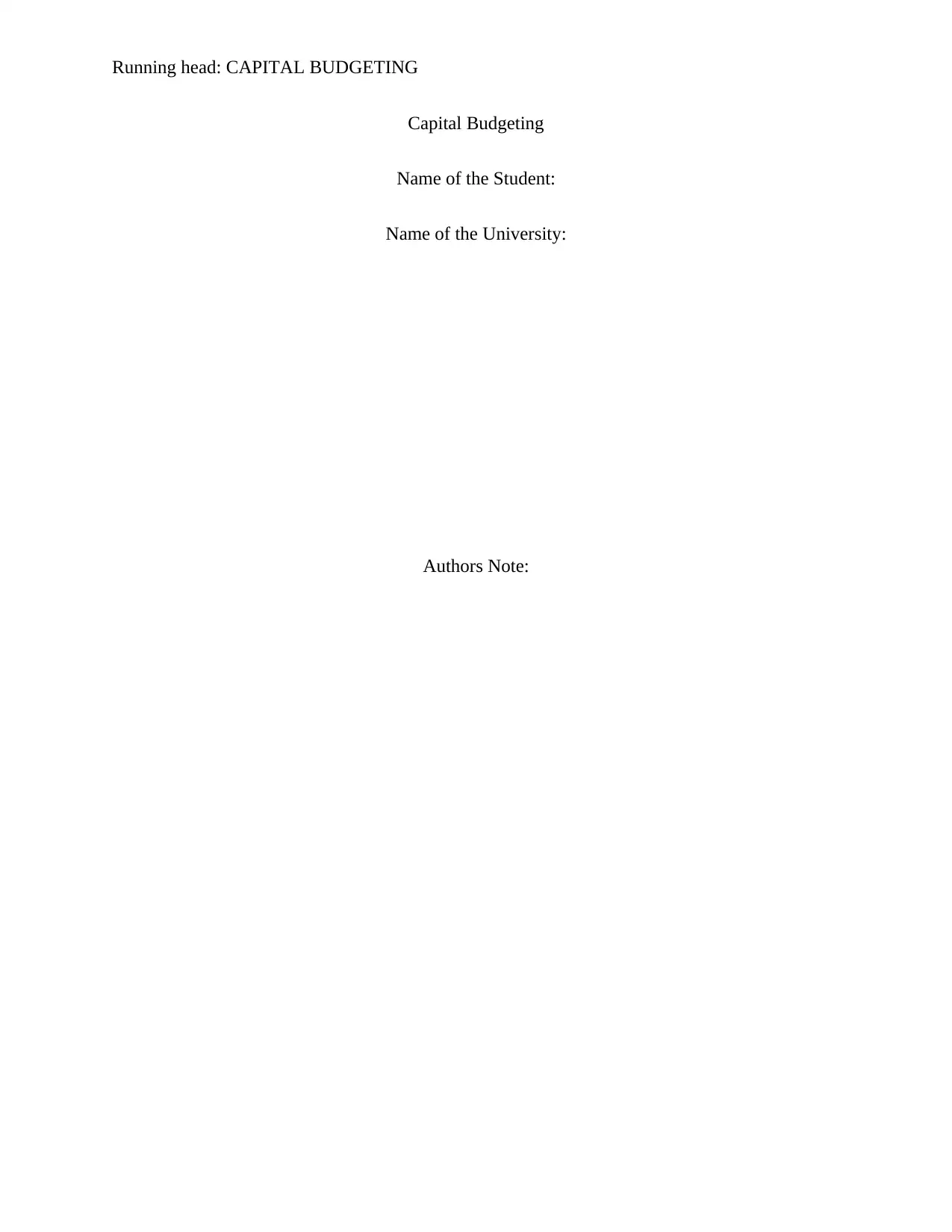
Running head: CAPITAL BUDGETING
Capital Budgeting
Name of the Student:
Name of the University:
Authors Note:
Capital Budgeting
Name of the Student:
Name of the University:
Authors Note:
Paraphrase This Document
Need a fresh take? Get an instant paraphrase of this document with our AI Paraphraser
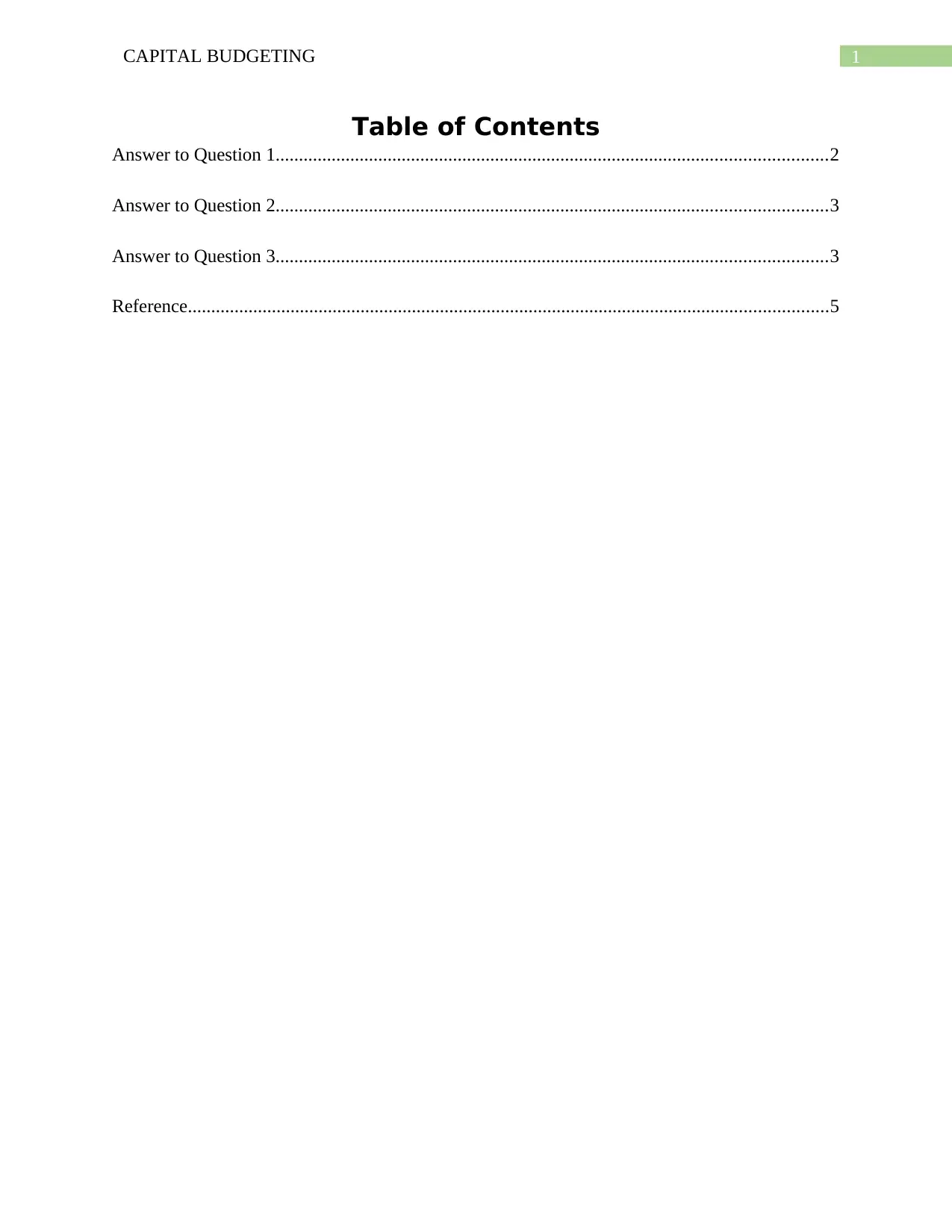
1CAPITAL BUDGETING
Table of Contents
Answer to Question 1......................................................................................................................2
Answer to Question 2......................................................................................................................3
Answer to Question 3......................................................................................................................3
Reference.........................................................................................................................................5
Table of Contents
Answer to Question 1......................................................................................................................2
Answer to Question 2......................................................................................................................3
Answer to Question 3......................................................................................................................3
Reference.........................................................................................................................................5
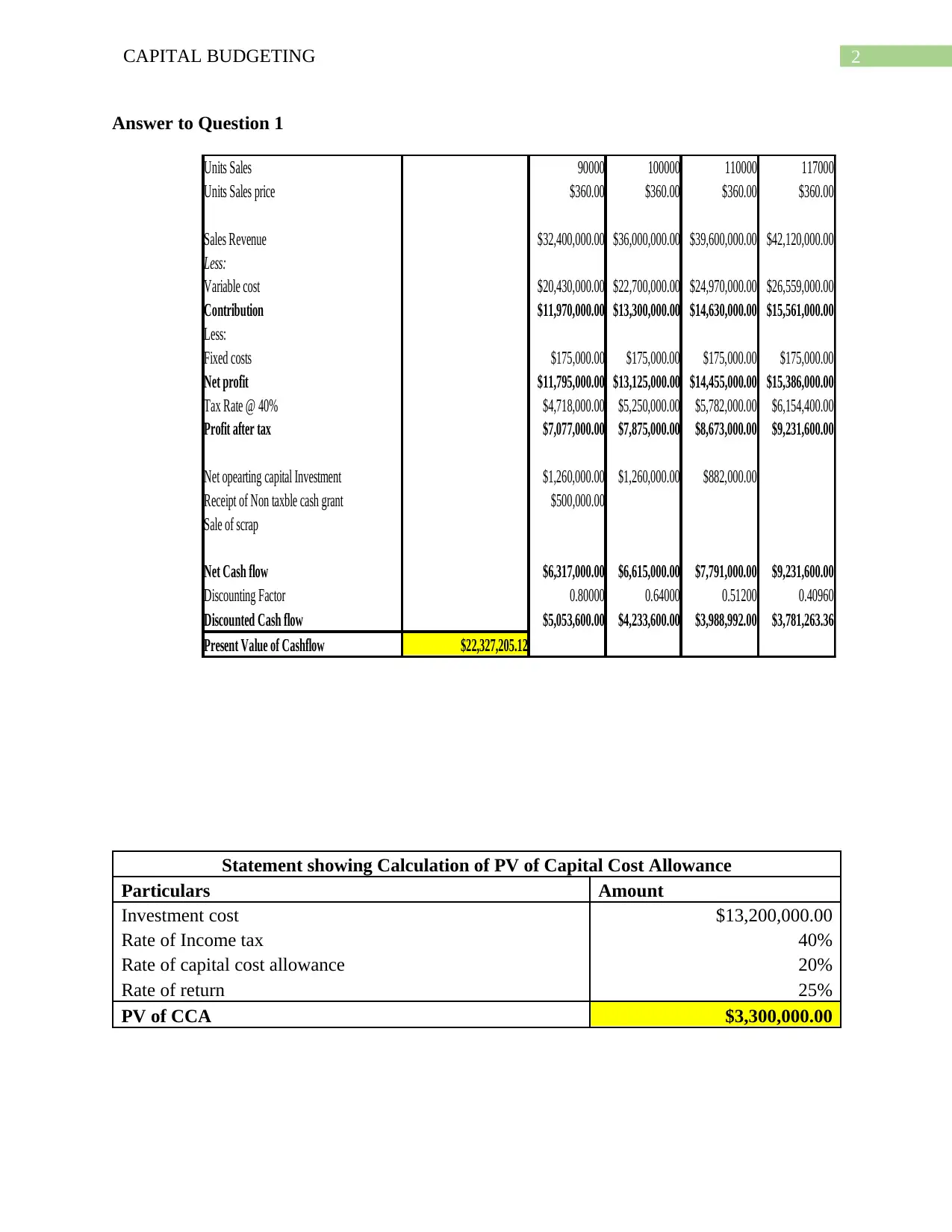
2CAPITAL BUDGETING
Answer to Question 1
Units Sales 90000 100000 110000 117000
Units Sales price $360.00 $360.00 $360.00 $360.00
Sales Revenue $32,400,000.00 $36,000,000.00 $39,600,000.00 $42,120,000.00
Less:
Variable cost $20,430,000.00 $22,700,000.00 $24,970,000.00 $26,559,000.00
Contribution $11,970,000.00 $13,300,000.00 $14,630,000.00 $15,561,000.00
Less:
Fixed costs $175,000.00 $175,000.00 $175,000.00 $175,000.00
Net profit $11,795,000.00 $13,125,000.00 $14,455,000.00 $15,386,000.00
Tax Rate @ 40% $4,718,000.00 $5,250,000.00 $5,782,000.00 $6,154,400.00
Profit after tax $7,077,000.00 $7,875,000.00 $8,673,000.00 $9,231,600.00
Net opearting capital Investment $1,260,000.00 $1,260,000.00 $882,000.00
Receipt of Non taxble cash grant $500,000.00
Sale of scrap
Net Cash flow $6,317,000.00 $6,615,000.00 $7,791,000.00 $9,231,600.00
Discounting Factor 0.80000 0.64000 0.51200 0.40960
Discounted Cash flow $5,053,600.00 $4,233,600.00 $3,988,992.00 $3,781,263.36
Present Value of Cashflow $22,327,205.12
Statement showing Calculation of PV of Capital Cost Allowance
Particulars Amount
Investment cost $13,200,000.00
Rate of Income tax 40%
Rate of capital cost allowance 20%
Rate of return 25%
PV of CCA $3,300,000.00
Answer to Question 1
Units Sales 90000 100000 110000 117000
Units Sales price $360.00 $360.00 $360.00 $360.00
Sales Revenue $32,400,000.00 $36,000,000.00 $39,600,000.00 $42,120,000.00
Less:
Variable cost $20,430,000.00 $22,700,000.00 $24,970,000.00 $26,559,000.00
Contribution $11,970,000.00 $13,300,000.00 $14,630,000.00 $15,561,000.00
Less:
Fixed costs $175,000.00 $175,000.00 $175,000.00 $175,000.00
Net profit $11,795,000.00 $13,125,000.00 $14,455,000.00 $15,386,000.00
Tax Rate @ 40% $4,718,000.00 $5,250,000.00 $5,782,000.00 $6,154,400.00
Profit after tax $7,077,000.00 $7,875,000.00 $8,673,000.00 $9,231,600.00
Net opearting capital Investment $1,260,000.00 $1,260,000.00 $882,000.00
Receipt of Non taxble cash grant $500,000.00
Sale of scrap
Net Cash flow $6,317,000.00 $6,615,000.00 $7,791,000.00 $9,231,600.00
Discounting Factor 0.80000 0.64000 0.51200 0.40960
Discounted Cash flow $5,053,600.00 $4,233,600.00 $3,988,992.00 $3,781,263.36
Present Value of Cashflow $22,327,205.12
Statement showing Calculation of PV of Capital Cost Allowance
Particulars Amount
Investment cost $13,200,000.00
Rate of Income tax 40%
Rate of capital cost allowance 20%
Rate of return 25%
PV of CCA $3,300,000.00
⊘ This is a preview!⊘
Do you want full access?
Subscribe today to unlock all pages.

Trusted by 1+ million students worldwide
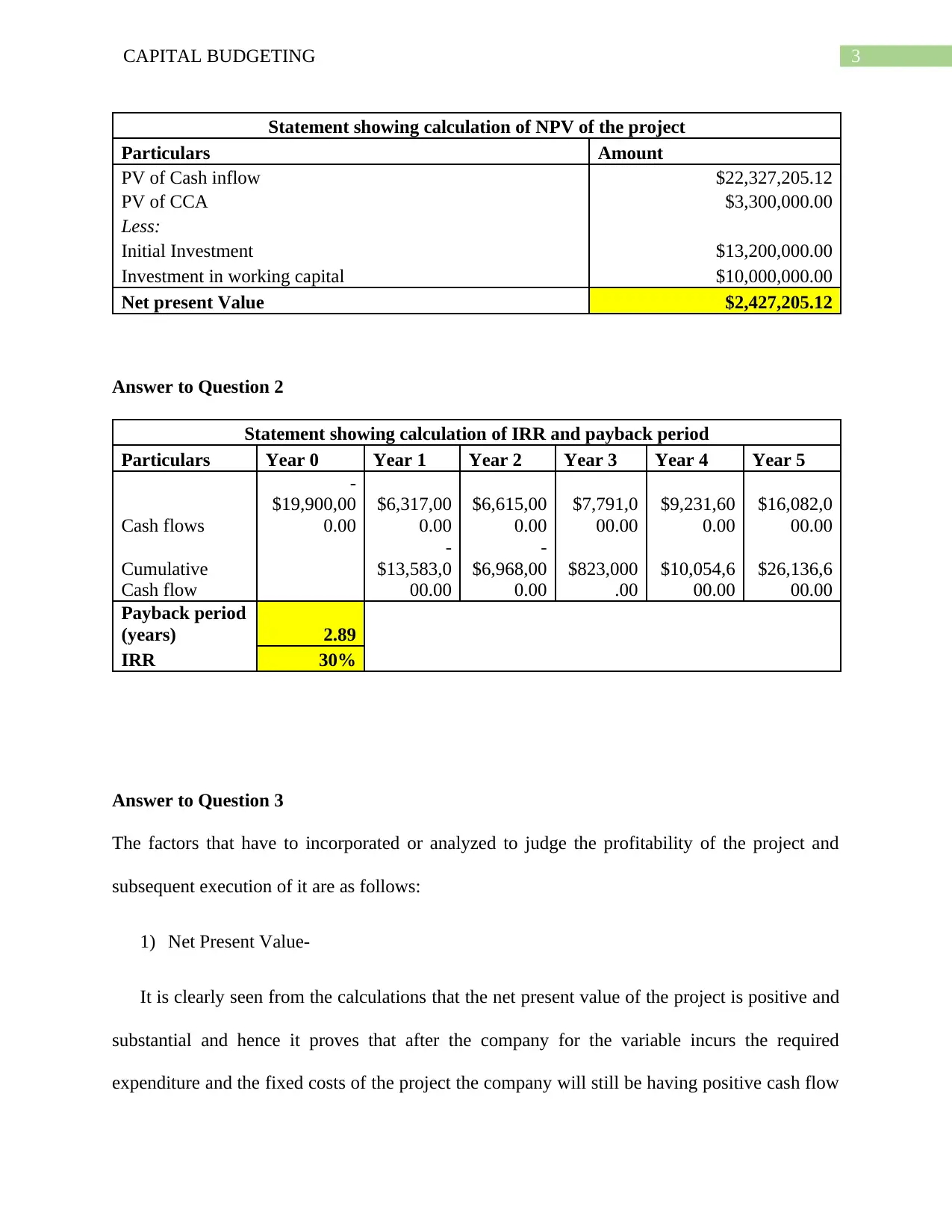
3CAPITAL BUDGETING
Statement showing calculation of NPV of the project
Particulars Amount
PV of Cash inflow $22,327,205.12
PV of CCA $3,300,000.00
Less:
Initial Investment $13,200,000.00
Investment in working capital $10,000,000.00
Net present Value $2,427,205.12
Answer to Question 2
Statement showing calculation of IRR and payback period
Particulars Year 0 Year 1 Year 2 Year 3 Year 4 Year 5
Cash flows
-
$19,900,00
0.00
$6,317,00
0.00
$6,615,00
0.00
$7,791,0
00.00
$9,231,60
0.00
$16,082,0
00.00
Cumulative
Cash flow
-
$13,583,0
00.00
-
$6,968,00
0.00
$823,000
.00
$10,054,6
00.00
$26,136,6
00.00
Payback period
(years) 2.89
IRR 30%
Answer to Question 3
The factors that have to incorporated or analyzed to judge the profitability of the project and
subsequent execution of it are as follows:
1) Net Present Value-
It is clearly seen from the calculations that the net present value of the project is positive and
substantial and hence it proves that after the company for the variable incurs the required
expenditure and the fixed costs of the project the company will still be having positive cash flow
Statement showing calculation of NPV of the project
Particulars Amount
PV of Cash inflow $22,327,205.12
PV of CCA $3,300,000.00
Less:
Initial Investment $13,200,000.00
Investment in working capital $10,000,000.00
Net present Value $2,427,205.12
Answer to Question 2
Statement showing calculation of IRR and payback period
Particulars Year 0 Year 1 Year 2 Year 3 Year 4 Year 5
Cash flows
-
$19,900,00
0.00
$6,317,00
0.00
$6,615,00
0.00
$7,791,0
00.00
$9,231,60
0.00
$16,082,0
00.00
Cumulative
Cash flow
-
$13,583,0
00.00
-
$6,968,00
0.00
$823,000
.00
$10,054,6
00.00
$26,136,6
00.00
Payback period
(years) 2.89
IRR 30%
Answer to Question 3
The factors that have to incorporated or analyzed to judge the profitability of the project and
subsequent execution of it are as follows:
1) Net Present Value-
It is clearly seen from the calculations that the net present value of the project is positive and
substantial and hence it proves that after the company for the variable incurs the required
expenditure and the fixed costs of the project the company will still be having positive cash flow
Paraphrase This Document
Need a fresh take? Get an instant paraphrase of this document with our AI Paraphraser
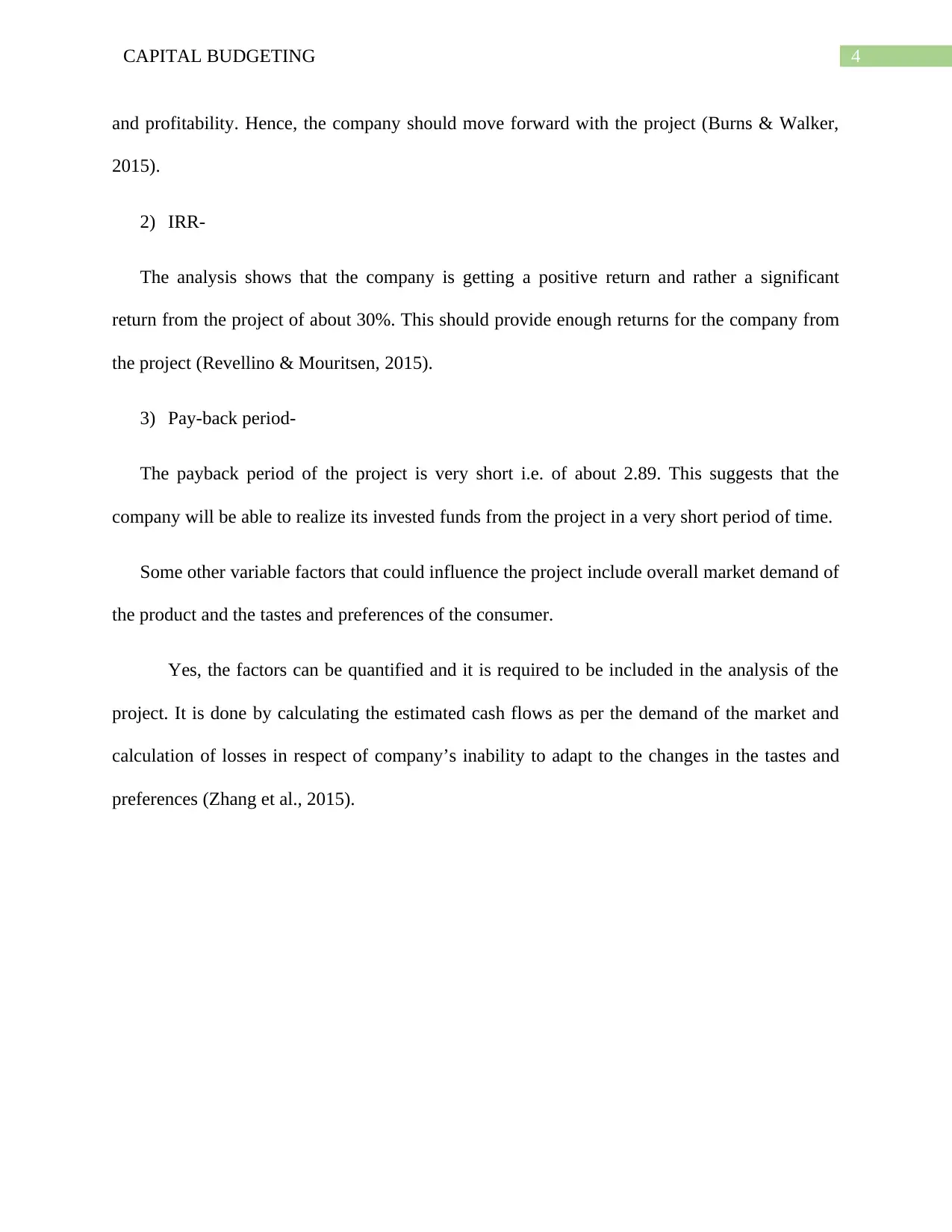
4CAPITAL BUDGETING
and profitability. Hence, the company should move forward with the project (Burns & Walker,
2015).
2) IRR-
The analysis shows that the company is getting a positive return and rather a significant
return from the project of about 30%. This should provide enough returns for the company from
the project (Revellino & Mouritsen, 2015).
3) Pay-back period-
The payback period of the project is very short i.e. of about 2.89. This suggests that the
company will be able to realize its invested funds from the project in a very short period of time.
Some other variable factors that could influence the project include overall market demand of
the product and the tastes and preferences of the consumer.
Yes, the factors can be quantified and it is required to be included in the analysis of the
project. It is done by calculating the estimated cash flows as per the demand of the market and
calculation of losses in respect of company’s inability to adapt to the changes in the tastes and
preferences (Zhang et al., 2015).
and profitability. Hence, the company should move forward with the project (Burns & Walker,
2015).
2) IRR-
The analysis shows that the company is getting a positive return and rather a significant
return from the project of about 30%. This should provide enough returns for the company from
the project (Revellino & Mouritsen, 2015).
3) Pay-back period-
The payback period of the project is very short i.e. of about 2.89. This suggests that the
company will be able to realize its invested funds from the project in a very short period of time.
Some other variable factors that could influence the project include overall market demand of
the product and the tastes and preferences of the consumer.
Yes, the factors can be quantified and it is required to be included in the analysis of the
project. It is done by calculating the estimated cash flows as per the demand of the market and
calculation of losses in respect of company’s inability to adapt to the changes in the tastes and
preferences (Zhang et al., 2015).
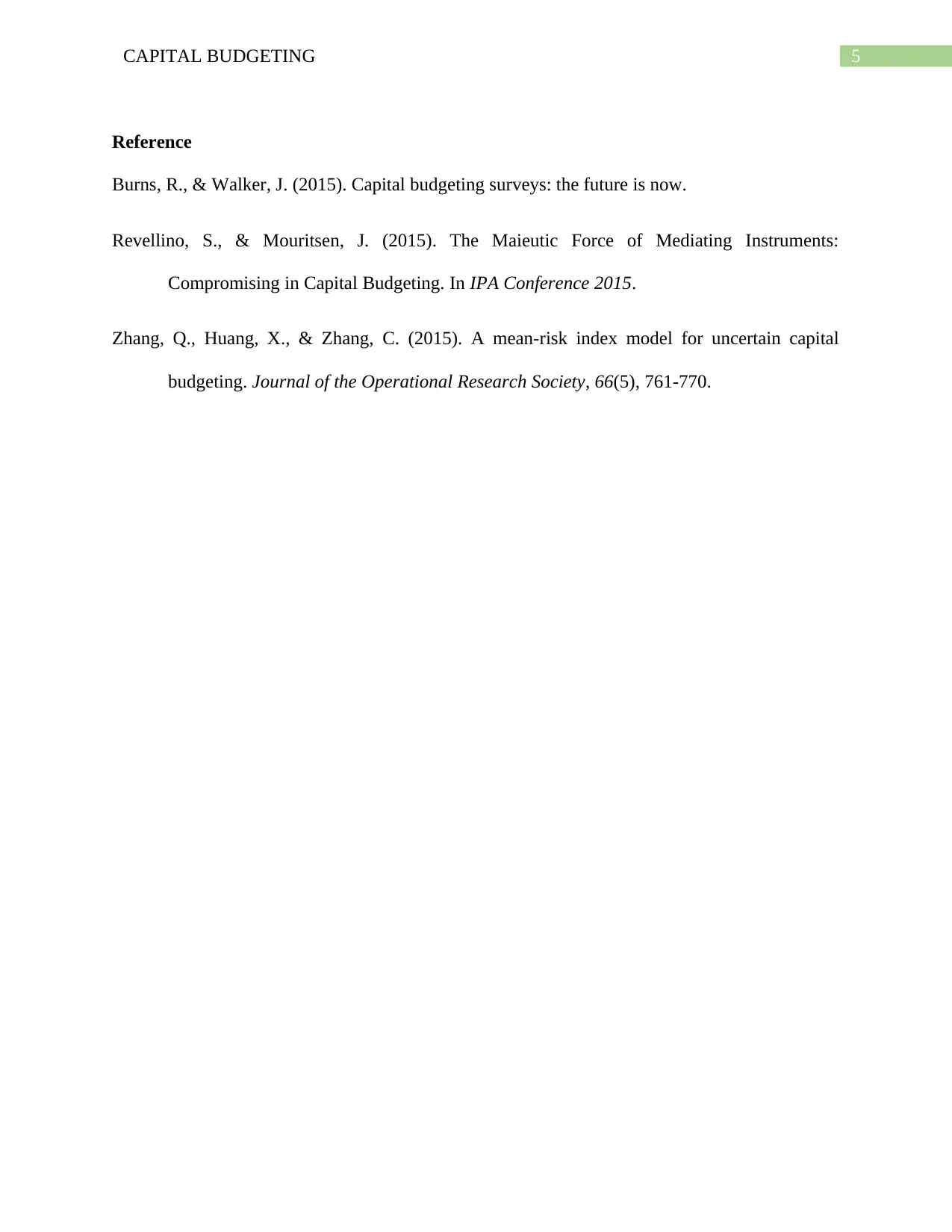
5CAPITAL BUDGETING
Reference
Burns, R., & Walker, J. (2015). Capital budgeting surveys: the future is now.
Revellino, S., & Mouritsen, J. (2015). The Maieutic Force of Mediating Instruments:
Compromising in Capital Budgeting. In IPA Conference 2015.
Zhang, Q., Huang, X., & Zhang, C. (2015). A mean-risk index model for uncertain capital
budgeting. Journal of the Operational Research Society, 66(5), 761-770.
Reference
Burns, R., & Walker, J. (2015). Capital budgeting surveys: the future is now.
Revellino, S., & Mouritsen, J. (2015). The Maieutic Force of Mediating Instruments:
Compromising in Capital Budgeting. In IPA Conference 2015.
Zhang, Q., Huang, X., & Zhang, C. (2015). A mean-risk index model for uncertain capital
budgeting. Journal of the Operational Research Society, 66(5), 761-770.
⊘ This is a preview!⊘
Do you want full access?
Subscribe today to unlock all pages.

Trusted by 1+ million students worldwide
1 out of 6
Related Documents
Your All-in-One AI-Powered Toolkit for Academic Success.
+13062052269
info@desklib.com
Available 24*7 on WhatsApp / Email
![[object Object]](/_next/static/media/star-bottom.7253800d.svg)
Unlock your academic potential
Copyright © 2020–2025 A2Z Services. All Rights Reserved. Developed and managed by ZUCOL.




